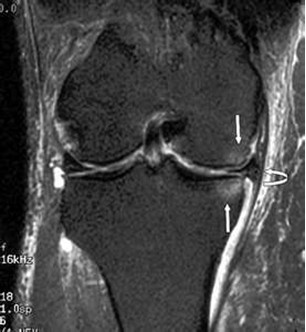

Knee swelling
knee swelling or edema in the knee joint may be a warning sign of severe knee degradation. If your knee is tingling, swollen, irritated, pain, need to seek medical advice as soon as possible.
Case Sharing
61-year-old Miss Wu suddenly found tingling, swelling, and inability to straighten or flex her knee on her left knee. The patient’s pain cannot be relieved after taking rest and taking pain medication and anti-inflammatory drugs. After doing a checkup, she found that her left knee was highly immobile, and she felt pain when she lightly touched her knee. Since then, the patient’s knees appeared red, swollen and inflamed that day, the initial diagnosis was acute inflammation of the knee joint degeneration.
After treatment and taking pain medicine and anti-inflammatory drugs several times, the condition did not get better, then further magnetic resonance imaging was required to follow up the condition. The result report showed that the patient’s knee cartilage was severely worn, the knee bone was severely degenerated, and the knee joint appears to be bone marrow edema.
Knee Bone Marrow Edema Symptoms
Knee Bone Marrow Edema occurs more commonly in large joints of the body, such as femoral joints, knee joints, and foot joints. The joints with bone marrow edema will become inflamed, swelling and painful, which are usually lead to degenerative arthritis.
Patients with knee bone marrow edema suffer from pain in the knee joints whether they are resting or moving. It seems that no posture can really relieve knee pain. The knees could not be flexed, straightened, or walked, the patient usually suffer pain. Usually, the knee feels pain when resting, this may be caused by a problem in the knee joint structure, such as the degeneration has reached a serious stage.
Treatment of Bone Marrow Edema
Patients with bone marrow edema can be relieved of pain through alternative treatment, usually through ultrasound, electrotherapy and stretching exercises to stretch muscles. The patient can also temporarily take analgesic and anti-inflammatory drugs to control the condition.
It usually takes a long time to treat this pain, ranging from 6 months to 1 year. In some minor cases, patients can recover within 6 to 12 months without any treatment. If the condition not only does not get better after treatment, but the knee pain gets worse, surgical treatment may be considered.
Prevention of Bone Marrow Edema
Bones degeneration is an inevitable stage. We can only maintain the condition as much as possible to slow down the degeneration. As for how to care for our bones, we must first strengthen our muscles and keep joints moving. In addition to eating more high-calcium foods, you should also do more exercises to strengthen bones, such as running, cycling, and swimming; the elderly can choose to walk or do Tai Chi, in addition, doing more muscle training, stretching and strengthening muscles exercise. If the knee joint is under pressure due to obesity for a long time, it will accelerate the degeneration of the joint. On the other hand, smokers should pay special attention because smoking accelerates bone loss and accelerates bone degeneration and loss; nutritional supplements can be used to help strengthen bone health, such as calcium tablets, omega fatty acids and water-soluble collagen (www.drdisc.hk)

White arrows show bone marrow edema

 Book an Appointment
Book an Appointment


